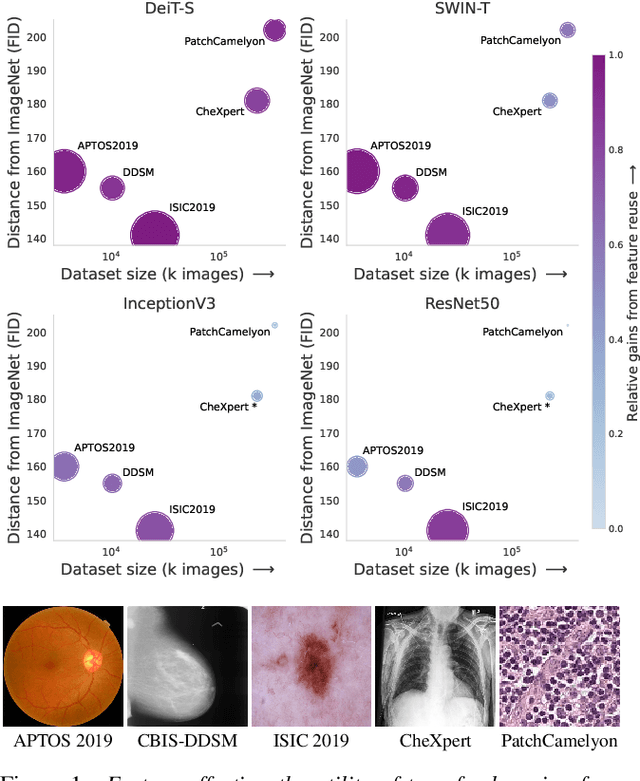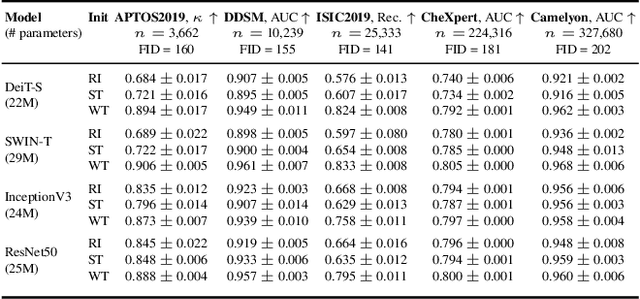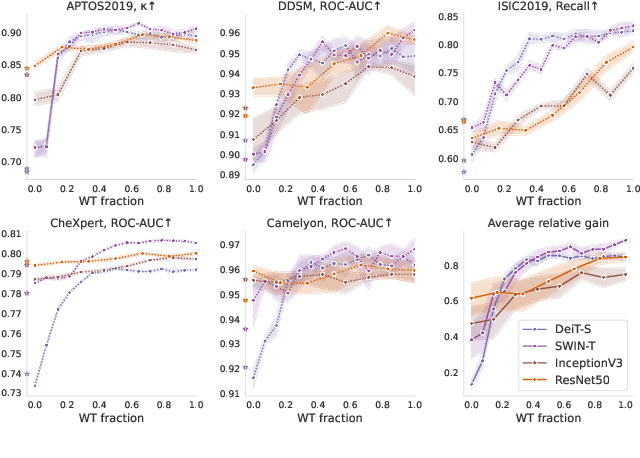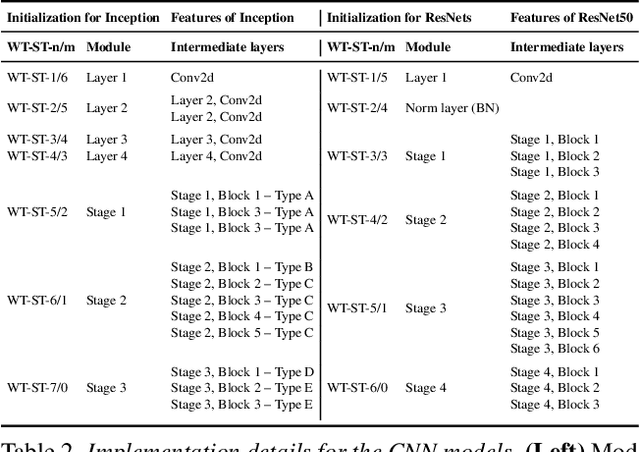Christos Matsoukas
Efficient Self-Supervised Adaptation for Medical Image Analysis
Mar 24, 2025Abstract:Self-supervised adaptation (SSA) improves foundation model transfer to medical domains but is computationally prohibitive. Although parameter efficient fine-tuning methods such as LoRA have been explored for supervised adaptation, their effectiveness for SSA remains unknown. In this work, we introduce efficient self-supervised adaptation (ESSA), a framework that applies parameter-efficient fine-tuning techniques to SSA with the aim of reducing computational cost and improving adaptation performance. Among the methods tested, Attention Projection Layer Adaptation (APLA) sets a new state-of-the-art, consistently surpassing full-parameter SSA and supervised fine-tuning across diverse medical tasks, while reducing GPU memory by up to 40.1% and increasing training throughput by 25.2%, all while maintaining inference efficiency.
APLA: A Simple Adaptation Method for Vision Transformers
Mar 14, 2025Abstract:Existing adaptation techniques typically require architectural modifications or added parameters, leading to high computational costs and complexity. We introduce Attention Projection Layer Adaptation (APLA), a simple approach to adapt vision transformers (ViTs) without altering the architecture or adding parameters. Through a systematic analysis, we find that the layer immediately after the attention mechanism is crucial for adaptation. By updating only this projection layer, or even just a random subset of this layer's weights, APLA achieves state-of-the-art performance while reducing GPU memory usage by up to 52.63% and training time by up to 43.0%, with no extra cost at inference. Across 46 datasets covering a variety of tasks including scene classification, medical imaging, satellite imaging, and fine-grained classification, APLA consistently outperforms 17 other leading adaptation methods, including full fine-tuning, on classification, segmentation, and detection tasks. The code is available at https://github.com/MoeinSorkhei/APLA.
Random Token Fusion for Multi-View Medical Diagnosis
Oct 21, 2024Abstract:In multi-view medical diagnosis, deep learning-based models often fuse information from different imaging perspectives to improve diagnostic performance. However, existing approaches are prone to overfitting and rely heavily on view-specific features, which can lead to trivial solutions. In this work, we introduce Random Token Fusion (RTF), a novel technique designed to enhance multi-view medical image analysis using vision transformers. By integrating randomness into the feature fusion process during training, RTF addresses the issue of overfitting and enhances the robustness and accuracy of diagnostic models without incurring any additional cost at inference. We validate our approach on standard mammography and chest X-ray benchmark datasets. Through extensive experiments, we demonstrate that RTF consistently improves the performance of existing fusion methods, paving the way for a new generation of multi-view medical foundation models.
Learning from Offline Foundation Features with Tensor Augmentations
Oct 03, 2024Abstract:We introduce Learning from Offline Foundation Features with Tensor Augmentations (LOFF-TA), an efficient training scheme designed to harness the capabilities of foundation models in limited resource settings where their direct development is not feasible. LOFF-TA involves training a compact classifier on cached feature embeddings from a frozen foundation model, resulting in up to $37\times$ faster training and up to $26\times$ reduced GPU memory usage. Because the embeddings of augmented images would be too numerous to store, yet the augmentation process is essential for training, we propose to apply tensor augmentations to the cached embeddings of the original non-augmented images. LOFF-TA makes it possible to leverage the power of foundation models, regardless of their size, in settings with limited computational capacity. Moreover, LOFF-TA can be used to apply foundation models to high-resolution images without increasing compute. In certain scenarios, we find that training with LOFF-TA yields better results than directly fine-tuning the foundation model.
Bridging Generalization Gaps in High Content Imaging Through Online Self-Supervised Domain Adaptation
Nov 21, 2023Abstract:High Content Imaging (HCI) plays a vital role in modern drug discovery and development pipelines, facilitating various stages from hit identification to candidate drug characterization. Applying machine learning models to these datasets can prove challenging as they typically consist of multiple batches, affected by experimental variation, especially if different imaging equipment have been used. Moreover, as new data arrive, it is preferable that they are analyzed in an online fashion. To overcome this, we propose CODA, an online self-supervised domain adaptation approach. CODA divides the classifier's role into a generic feature extractor and a task-specific model. We adapt the feature extractor's weights to the new domain using cross-batch self-supervision while keeping the task-specific model unchanged. Our results demonstrate that this strategy significantly reduces the generalization gap, achieving up to a 300% improvement when applied to data from different labs utilizing different microscopes. CODA can be applied to new, unlabeled out-of-domain data sources of different sizes, from a single plate to multiple experimental batches.
Are Natural Domain Foundation Models Useful for Medical Image Classification?
Oct 30, 2023Abstract:The deep learning field is converging towards the use of general foundation models that can be easily adapted for diverse tasks. While this paradigm shift has become common practice within the field of natural language processing, progress has been slower in computer vision. In this paper we attempt to address this issue by investigating the transferability of various state-of-the-art foundation models to medical image classification tasks. Specifically, we evaluate the performance of five foundation models, namely SAM, SEEM, DINOv2, BLIP, and OpenCLIP across four well-established medical imaging datasets. We explore different training settings to fully harness the potential of these models. Our study shows mixed results. DINOv2 in particular, consistently outperforms the standard practice of ImageNet pretraining. However, other foundation models failed to consistently beat this established baseline indicating limitations in their transferability to medical image classification tasks.
Pretrained ViTs Yield Versatile Representations For Medical Images
Mar 14, 2023Abstract:Convolutional Neural Networks (CNNs) have reigned for a decade as the de facto approach to automated medical image diagnosis, pushing the state-of-the-art in classification, detection and segmentation tasks. Over the last years, vision transformers (ViTs) have appeared as a competitive alternative to CNNs, yielding impressive levels of performance in the natural image domain, while possessing several interesting properties that could prove beneficial for medical imaging tasks. In this work, we explore the benefits and drawbacks of transformer-based models for medical image classification. We conduct a series of experiments on several standard 2D medical image benchmark datasets and tasks. Our findings show that, while CNNs perform better if trained from scratch, off-the-shelf vision transformers can perform on par with CNNs when pretrained on ImageNet, both in a supervised and self-supervised setting, rendering them as a viable alternative to CNNs.
Metadata-guided Consistency Learning for High Content Images
Dec 22, 2022Abstract:High content imaging assays can capture rich phenotypic response data for large sets of compound treatments, aiding in the characterization and discovery of novel drugs. However, extracting representative features from high content images that can capture subtle nuances in phenotypes remains challenging. The lack of high-quality labels makes it difficult to achieve satisfactory results with supervised deep learning. Self-Supervised learning methods, which learn from automatically generated labels has shown great success on natural images, offer an attractive alternative also to microscopy images. However, we find that self-supervised learning techniques underperform on high content imaging assays. One challenge is the undesirable domain shifts present in the data known as batch effects, which may be caused by biological noise or uncontrolled experimental conditions. To this end, we introduce Cross-Domain Consistency Learning (CDCL), a novel approach that is able to learn in the presence of batch effects. CDCL enforces the learning of biological similarities while disregarding undesirable batch-specific signals, which leads to more useful and versatile representations. These features are organised according to their morphological changes and are more useful for downstream tasks - such as distinguishing treatments and mode of action.
PatchDropout: Economizing Vision Transformers Using Patch Dropout
Aug 10, 2022



Abstract:Vision transformers have demonstrated the potential to outperform CNNs in a variety of vision tasks. But the computational and memory requirements of these models prohibit their use in many applications, especially those that depend on high-resolution images, such as medical image classification. Efforts to train ViTs more efficiently are overly complicated, necessitating architectural changes or intricate training schemes. In this work, we show that standard ViT models can be efficiently trained at high resolution by randomly dropping input image patches. This simple approach, PatchDropout, reduces FLOPs and memory by at least 50% in standard natural image datasets such as ImageNet, and those savings only increase with image size. On CSAW, a high-resolution medical dataset, we observe a 5 times savings in computation and memory using PatchDropout, along with a boost in performance. For practitioners with a fixed computational or memory budget, PatchDropout makes it possible to choose image resolution, hyperparameters, or model size to get the most performance out of their model.
What Makes Transfer Learning Work For Medical Images: Feature Reuse & Other Factors
Mar 02, 2022



Abstract:Transfer learning is a standard technique to transfer knowledge from one domain to another. For applications in medical imaging, transfer from ImageNet has become the de-facto approach, despite differences in the tasks and image characteristics between the domains. However, it is unclear what factors determine whether - and to what extent - transfer learning to the medical domain is useful. The long-standing assumption that features from the source domain get reused has recently been called into question. Through a series of experiments on several medical image benchmark datasets, we explore the relationship between transfer learning, data size, the capacity and inductive bias of the model, as well as the distance between the source and target domain. Our findings suggest that transfer learning is beneficial in most cases, and we characterize the important role feature reuse plays in its success.
 Add to Chrome
Add to Chrome Add to Firefox
Add to Firefox Add to Edge
Add to Edge